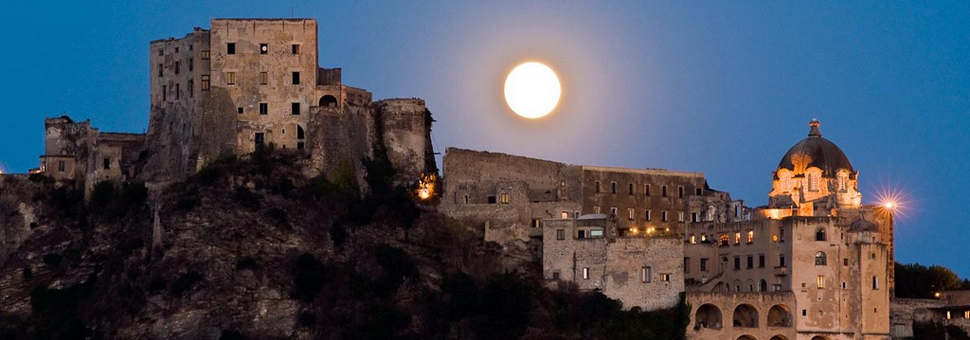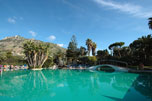Description
The Castello Aragonese stands on an islet of trachytic rock linked to the East side of the island of Ischia by a bridge of 220m long. The rocky base is geologically defined as "a dome of stagnation" and is equivalent to a bubble of magna which solidified throughout eruptions of vast ranges. It is 113 m high under the sea level and stretches on 56.000 square meters.It’s reachable by a mule track or a modern elevator built at the end of 1970s.
The mule track consists of a gallery dug into the rock (by Alfonso I of Aragon in the middle of the XV century) and Maschio.
From this main street, there are other ones more small to link builds and gardens of the fortress. The elevator is 60m under the sea level and its way is dug into the rock.
The build consists of lands and ruins; that one was the original form in the XVIII century, collapsed in the next century because of wars and long time of neglect. Only in the early twentieth began a systematic campaign of restoration still in progress, that has guaranteed an architectural style.
So evident in the representation of Castello Aragonese is the royal residence image, called Maschio (which can not be visited) and placed on the highest point to the the North East side and the cupola of the church of Immacolata, central counterpoint throughout the islet.
Important passage between the rocky ribs and the built up area is the fortification around the castle.
History
The first fortress was built in 474 B.C. by the Greek Hieron I of Syracuse, come to Cumani aid during the war against Tyrrhenian. Other towers were raised up to monitor the movement of enemy ships. Ended the war, Hieron conquered the Island. It was later occupied by Parthenopeans. In 326 B.C. the Romans took it over and then again Parthenopeans. The looting and the long dominations of the Visigoths, Vandals, Goths, Arabs, Normans, Swabians, Angioini changed the Hieron’s fortress. In 1301 the last eruption of Epomeo destroyed the city of Geronda, the actual pinewood: people took refuge on the island. In 1441 Alfonso of Aragon re built the old Castle, linking the islet to the main island by a bridge artificial and built strong walls and fortifications, where everybody found refuge against the pirate invasions. In early XVIII century the islet hosted 1892 families, further the Convent of Poor Clares, the abbey of Brazilian from Greece, the bishop with Capitolo and Seminario, the Prince for healing. There were 13 churches, whose 7 parishes. In 1750, stopped the pirate’s danger, people searched a more easy refuge in the municipalities of the island. In 1809 the British besieged the fortress and drove out the French and shelled it up to almost completely destroy it. In 1823 the king of Naples fought off the last 30 inhabitants and turned the Castle into a place of punishment. Later, it become a house arrest.Info
Ischia Ponte
Municipality: Ischia - 80077
Period: III cen. - XVIII cen
Hours: 09:30 - 19:00
Ticket: full price € 10.00, reduced € 6.00, elementary schools € 3,00.
Box office: 081 992834
e-mail:
This e-mail address is being protected from spambots. You need JavaScript enabled to view it
Percorso guidato in pdf
Bus lines: 15 - 7
Near to
Porto di Ischia
Hotel Il Monastero
Ristorante da Coco
Spiaggia dei Pescatori
Baia di Cartaromana
Borgo di Celso
Galleria Ielasi
Il Museo del Mare
Il Museo delle Armi
Castello Aragonese
Chiesa dello Spirito Santo
S. Maria di Costantinopoli
S. Maria della Assunta
P. Termale Il Giardino Eden
Farmacia Mirabella






















